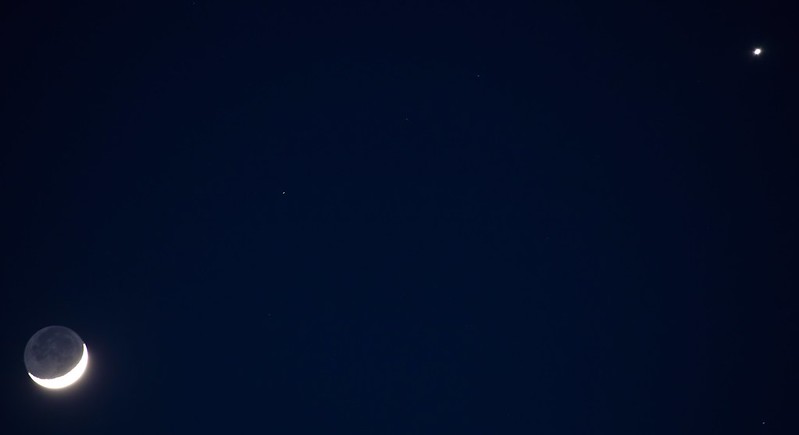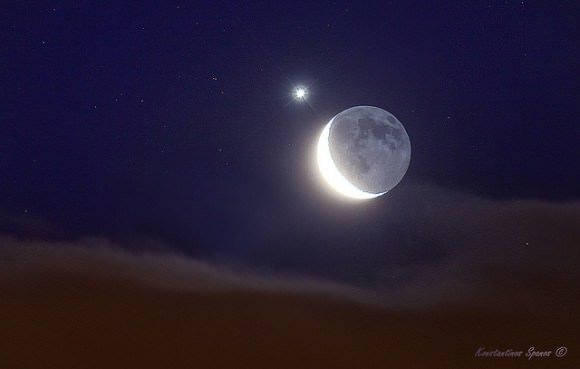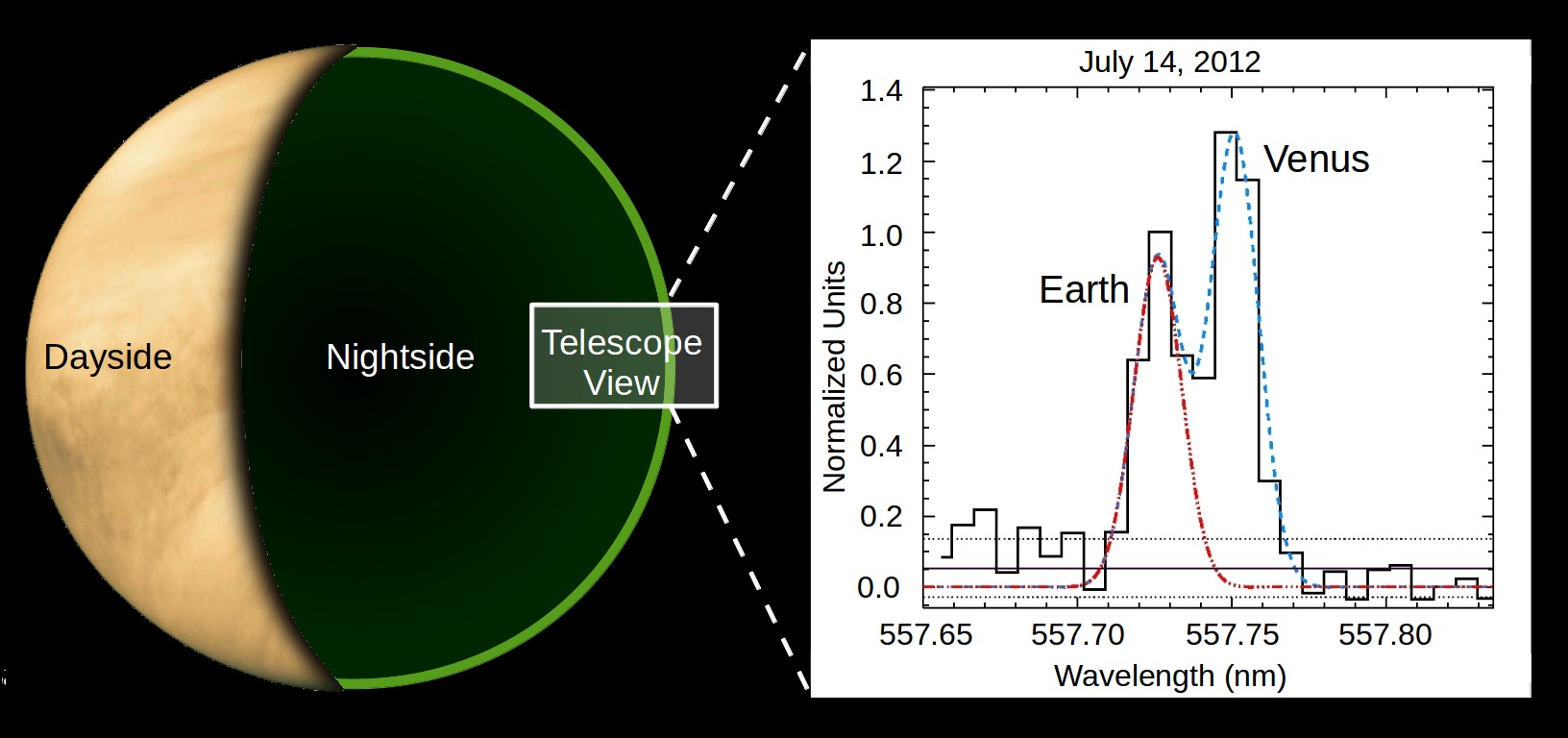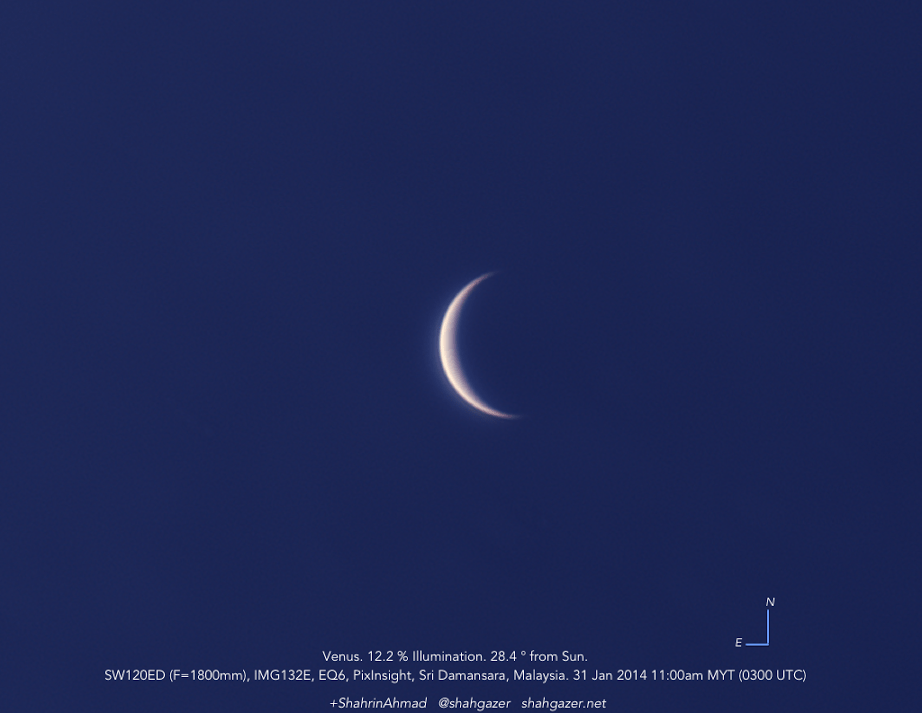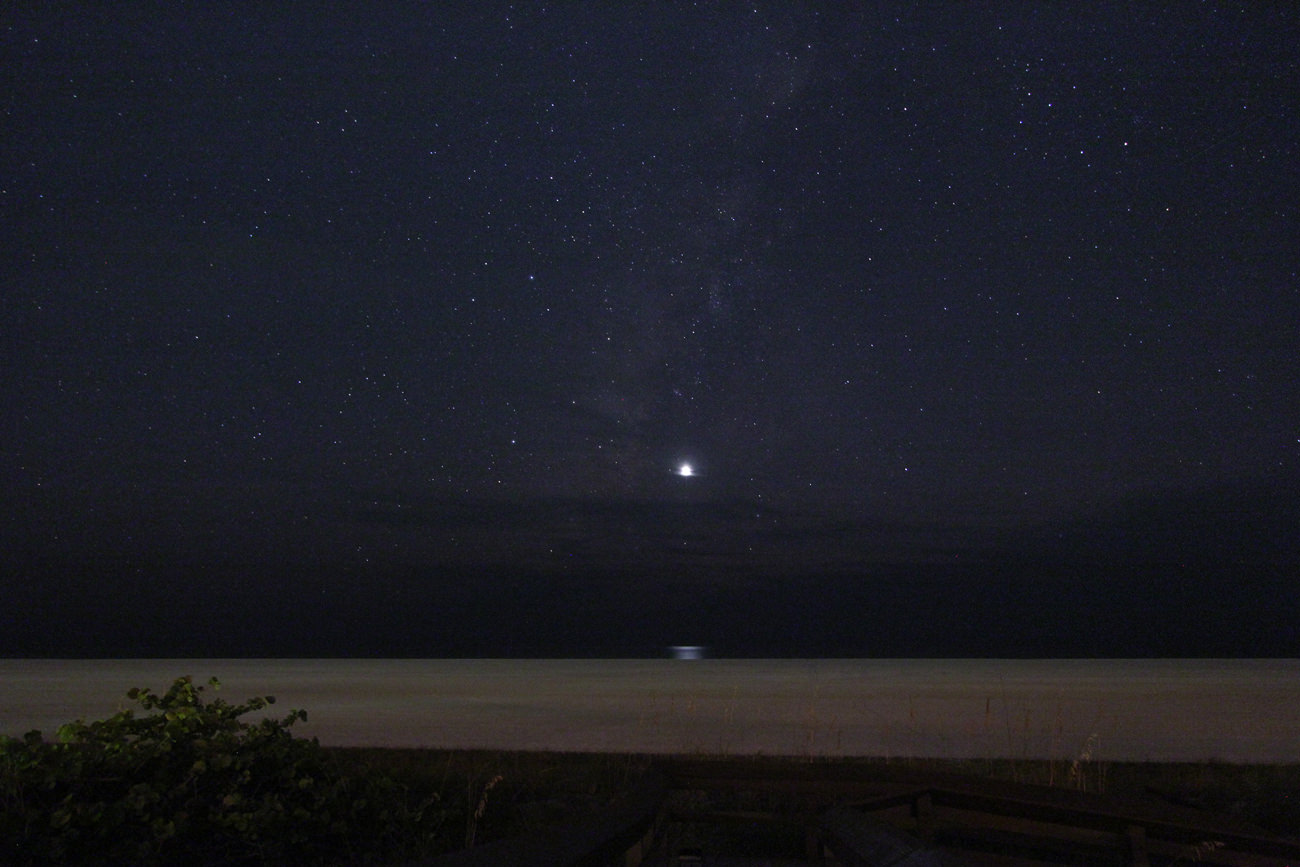Where have all the planets gone in early 2020? While most of the naked eye planets are hiding in the early dawn sky, one world dominates the evening: brilliant Venus.
Continue reading “Following the Inner Worlds: Mercury and Venus in 2020”Astro-Challenge: Watch the Moon Occult Venus in the Daytime
The year 2015 saved one of the best astronomical events for last, as the waning crescent Moon occults (passes in front of) the planet Venus as seen from North America on Monday, December 7th.
This is the final of seven naked eye occultations of planets by the Moon in 2015, three of which involve Venus. It’s also the best of the year, well positioned for North America. Continue reading “Astro-Challenge: Watch the Moon Occult Venus in the Daytime”
Can Lunar Earthshine Reveal Ashen Light on Venus?
A recent celestial event provided a fascinating look at a long-standing astronomical mystery.
Is the ‘ashen light of Venus’ a real phenomena or an illusion?
On October 8th, the waning crescent Moon occulted (passed in front of) the bright planet Venus for observers in the southern hemisphere. And while such occurrences aren’t at all rare—the Moon occults Venus 3 times in 2015, and 25 times in this decade alone worldwide—the particulars were exceptional for observers in Australia, with a -4.5 magnitude, 40% illuminated Venus 30” in size emerging under dark skies 45 degrees west of the Sun from behind the dark limb of the Moon.
David and Joan Dunham rose to the challenge, and caught an amazing sequence featuring a brilliant Venus reappearing from behind the Moon as seen from the Australian Outback. When I first watched the video posted on You Tube by International Occultation Timing Association (IOTA) North American coordinator Brad Timerson, I was a bit perplexed, until I realized we were actually seeing the dark nighttime side of a waning Moon, with the bright crescent just out of view. Venus fully emerges in just under a minute after first appearing, and its -4th magnitude visage shines like a spotlight when revealed in its full glory.
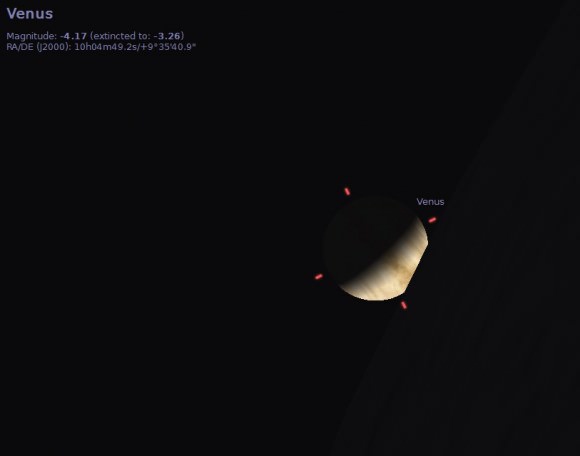
“Joan and I observed the reappearance of Venus from behind the dark side of the 15% sunlit waning crescent Moon, from a dark and wide parking area on the east side of the Stuart Highway that afforded a low (1-2 degree) horizon to the east,” Dunham said. “Since the past observations of ashen light were visual, I decided that it would be best to use the 25mm eyepiece with the 8-inch visually rather than just make a redundant video. Neither the real-time visual observation, nor close visual inspection of the video recording, showed any sign of the dark side of Venus.”
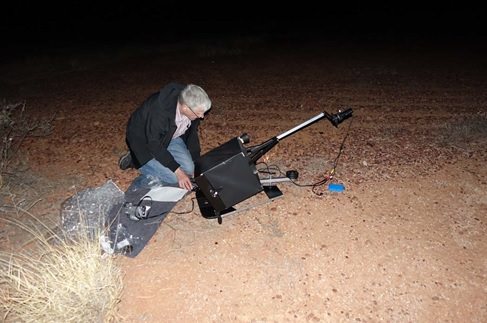
We’ve written about the strange puzzle of ashen light on the nighttime side of Venus previously.
Reports by visual observers of ashen light on the dark limb of Venus over the centuries remain a mystery. On the crescent Moon, it’s easy to explain, as the Earth illuminates the nighttime side of our natural satellite; no such nearby illumination source exists in the case of Venus. Ashen light on Venus is either an illusion—a trick of the dazzling brilliance of a crescent Venus fooling the eye of the observer—or a real, and not as yet fully described phenomenon. Over the years, suggestions have included: lightning, airglow, volcanism, and aurora. A good prime candidate in the form of an ‘auroral nightglow” was proposed by New Mexico State University researchers in 2014. 19th century astronomers even proposed we might be seeing the lights of Venusian cities, or perhaps forest fires!
Could we ever separate the bright crescent of Venus from its nighttime side? A lunar occultation, such as the October 8th event provides just such a fleeting opportunity. Though it’s hard to discern in the video, Dunham also watched the event visually through the telescope, and noted that, in his words, “the dark side of Venus remains dark,” with no brief appearance prior to sighting the crescent shining through the lunar valleys.
A tentative light curve made by Mr. Timerson seems to support this assertion, as the appearance of Venus quickly over-saturates the view:
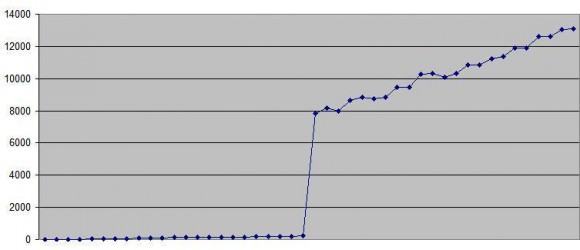
Of course, this is far from conclusive, but seems to support the idea that the ashen light of Venus noted by ground observers is largely an optical illusion. Not all occultations of Venus by the Moon are created equal, and the best ones to test this method occur when Venus is less than half illuminated and greater than 40 degrees from the Sun against a relatively dark sky. Compounding problems, the ‘dark’ limb of the Moon has a brightness of its own, thanks to Earthshine. Dunham notes that observers in southern Alaska may have another shot at seeing this same phenomenon on December 7th, when the 13% illuminated crescent Moon occults a -4.2 magnitude 69% illuminated Venus, 42 degrees west of the Sun… the rest of North and South America will see this occultation in the daytime, still an interesting catch.
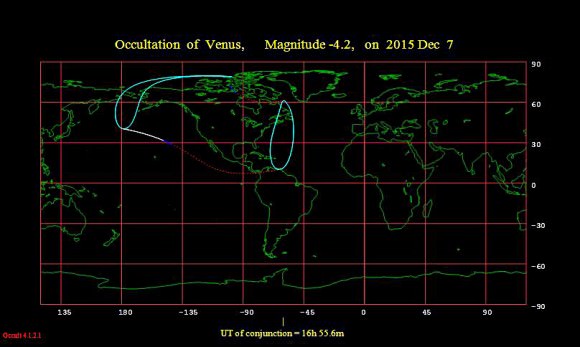
Looking at future occultations, there’s an intriguing possibility to hunt for the ashen light on the evening of October 10th, 2029, when then Moon occults a 57% illuminated Venus against dark skies for observers along the U.S. West Coast. Incidentally, a dawn occultation provides a better circumstance than a dusk one, as Venus always reemerges from the Moon’s dark limb when it’s waning. It enters the same when waxing, perhaps allowing for observer bias.
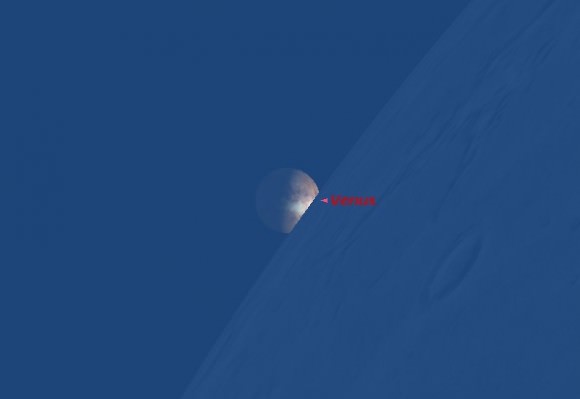
Can’t wait for December? The Moon also occults the bright star Aldebaran on October 29th for Europe and North America on November 26th near Full phase… the good folks at the Virtual Telescope will carry the October event live.
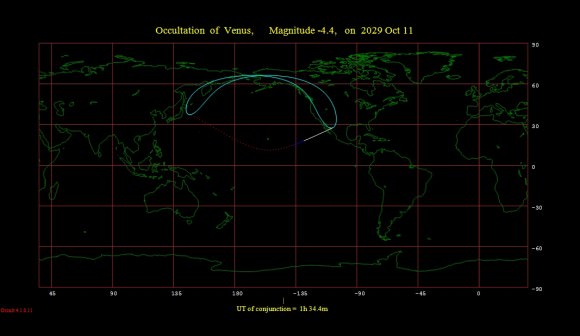
For now, the ashen light of Venus remains an intriguing mystery. Perhaps, an airborne observation could extend the appearance of Venus during an occultation, or maybe the recently announced Discovery-class mission to Venus could observe the night side of the planet for an Earthly glow… if nothing else, it’s simply amazing to watch the two brightest objects in the nighttime sky come together.
Aurora on Venus Versus Solar Activity
It’s a major mystery posed by our sister world.
Does the atmosphere of Venus possess upper atmospheric phenomena similar to the Earth, such as aurora or nightglow?
Now, a recent announcement out of the American Astronomical Society’s 46th annual meeting of the Division of Planetary Science being held this week in Tucson, Arizona has shed new light on the dilemma.
The discovery was announced on Wednesday, November 12th at the 46th AAS meeting and was made as a collaborative effort by researchers from New Mexico State University at Las Cruces, the Stanford Research Institute (SRI) International, the University of Colorado at Boulder, the University of Koln and University of Munich, Germany, the European Space and Technology Center in the Netherlands and the Institut de Recherche en Astrophysique et Planétologie, in France.
For the study, researchers observed Venus from December 2010 to July 2012 using the Astrophysical Research Consortium (ARC)Echelle Spectrograph and the ARC 3.5 metre telescope located at Apache Point near Sunspot, New Mexico.
Timing was crucial, as the Sun was coming off of a profound deep minimum through 2009 and just beginning to become active with the start of solar cycle #24. Observers were looking for activity along the 5577.3 angstrom wavelength known as the “oxygen green line.” Activity had not been seen at this wavelength on the nighttime side of Venus since 2004.
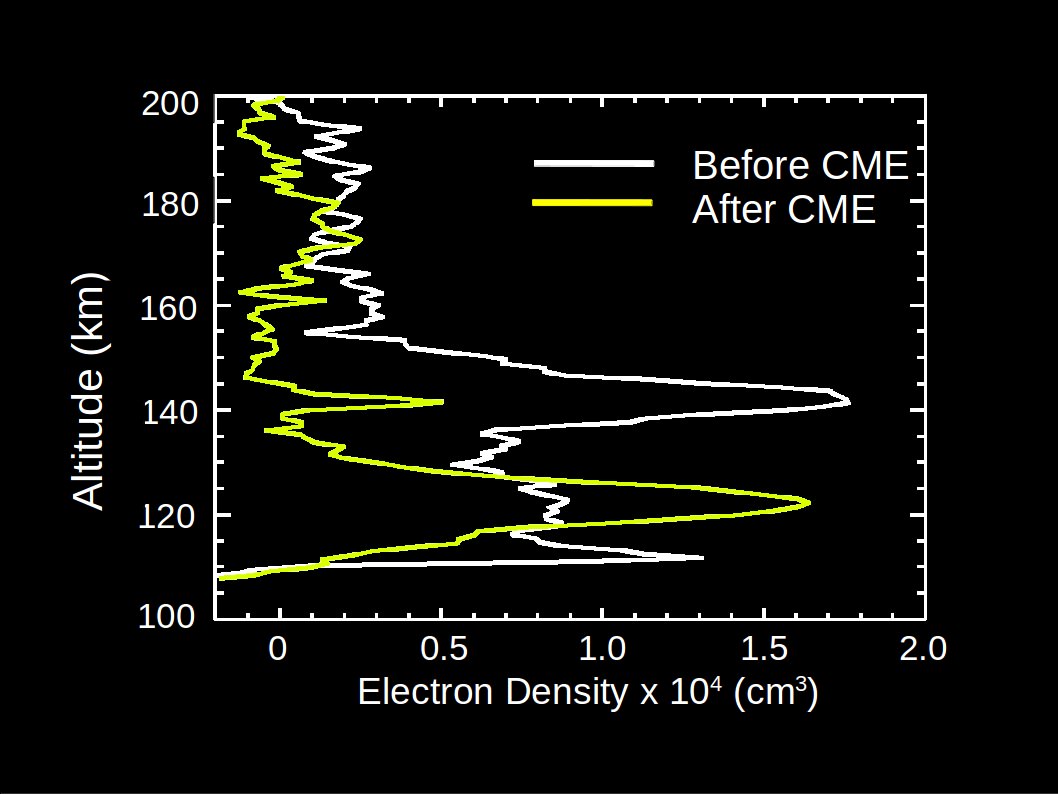
“These are intriguing results, suggesting that it is possible to have aurora on non-magnetic planets,” said Candace Gray, Astronomer and NASA Earth and Space Science Fellow at Las Cruces and lead researcher in the study. “On Venus, this green line has been seen only intermittently.”
Earth is the oddball among the terrestrial planets in the inner solar system with its robust magnetic field. On Earth, aurorae occur when said field captures charged particles ejected from the Sun and funnels them in towards the poles. Events seen in the study tended to drop 140 to 120 kilometres in altitude in the Venusian atmosphere, highly suggestive of auroral activity seen in the ionosphere of Earth.
Researchers were fortunate during one of the recent runs at Apache Point that the Sun kicked off a coronal mass ejection that headed Venus’s way. During the July 2012 solar storm, the team detected one of the brightest green line emissions that had ever been detected by observers on Earth.
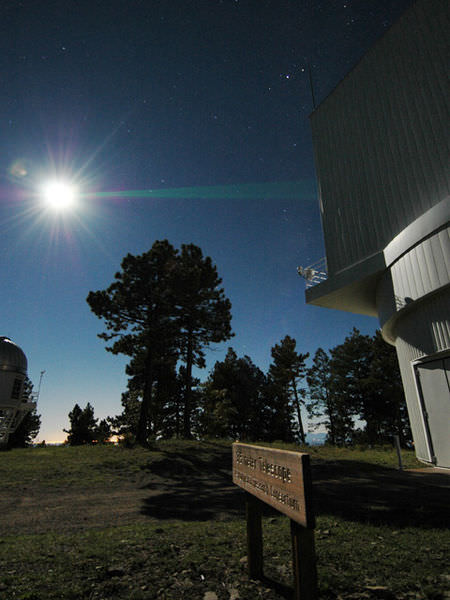
This demonstrates that perhaps, a magnetic field is optional when it comes to auroral activity, at least in the case of the planet Venus. Located only 0.7 astronomical units (108.5 million kilometres) from the Sun, our tempestuous star actually wraps the planet with its very own magnetotail.
Researchers are also looking to compare their results with observations from the European Space Agency’s Venus Express orbiter which arrived at the planet on April 2006.
“Currently, we are using observations from VIRTIS on Venus Express to try and detect the green line,” Gray told Universe Today. “We had coordinated ground based observations with them this past February, and we detected the green line from the ground when they were observing the night side limb. Additionally, we are using the Electron Spectrometer and ASPERA-4 to observe how the electron energy and density changes in the atmosphere after coronal mass ejection impacts.”
This also raises the interesting possibility that NASA’s MAVEN spacecraft — which recently arrived in orbit around Mars — might just detect similar activity in the tenuous Martian atmosphere as well. Like Venus, the Red Planet also lacks a global magnetic field.
Could this glow be connected with spurious sightings of the “Ashen Light of Venus” that have cropped up over the centuries?
Of course, ashen light, also known as Earthshine on the dark limb of the Moon, is easily explained as sunlight reflected back from the Earth. Moonless Venus, however, should be ashen light free.
“The green line emission that we see is brightest on the limb (edge) of the planet,” Gray told Universe Today. “We’re sure that there is emission all along the nightside, but because of the optical depth, it appears much brighter on the limb of the planet. I think it would be too faint to detect with the naked eye.”
Nightglow has been a leading suspect for ashen light on the Venusian nightside, and a similar green line emission detection rivaling the 2012 event was made by Tom Slanger using the Keck I telescope 1999.
Other proposed suspects over the centuries for ashen light on Venus include lightning, volcanism, light pollution (!) from Venusian cities, or just plain old observer error.
Certainly, future observations are needed to cinch the solar activity connection.
“We will likely observe Venus again from Apache Point the next time Venus is visible to us in June 2015,” Gray told Universe Today. “We will continue looking at Venus Express observations until the craft dies in the atmosphere.”
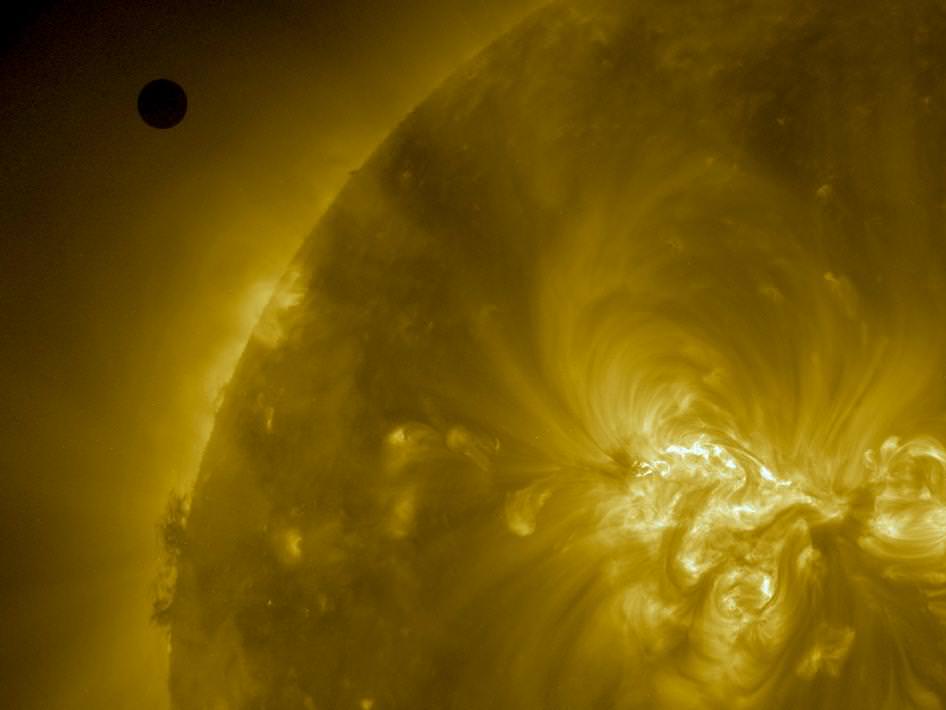
Venus can currently be seen crossing through the field of view of SOHO’s LASCO C3 camera. After spending most of 2014 in the dawn sky, Venus will emerge from behind the Sun low in the dusk to head towards greatest elongation in the evening sky on June 6th, 2015. And from there, Venus will once again slender towards a crescent, presenting its nightside towards Earth, and just perhaps, continuing to present a lingering mystery of modern astronomy.
Watch the Moon Meet Venus in the Dawn this Wednesday
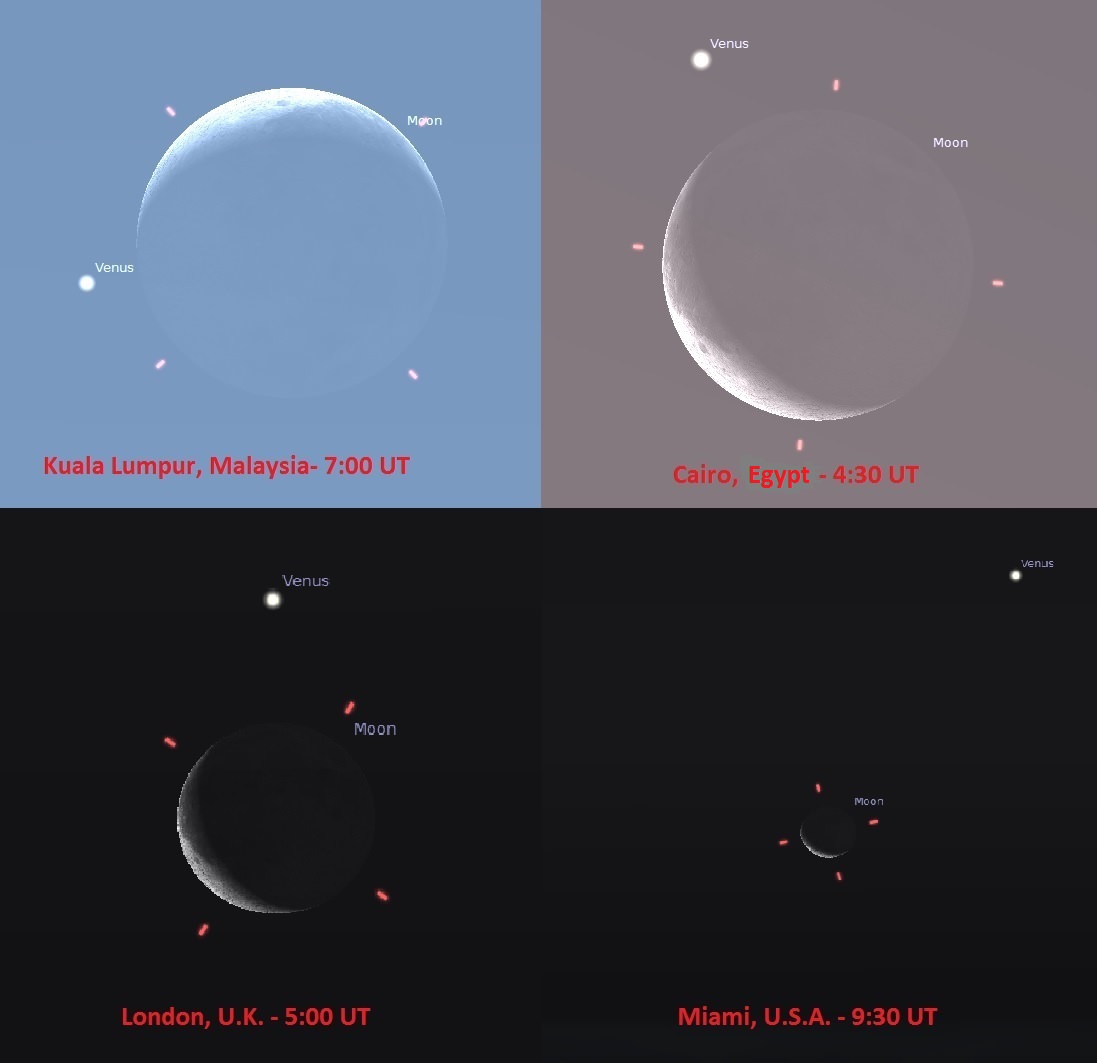
Are you ready for some lunar versus planetary occultation action? One of the best events for 2014 occurs early this Wednesday morning on February 26th, when the waning crescent Moon — sometimes referred to as a decrescent Moon — meets up with a brilliant Venus in the dawn sky. This will be a showcase event for the ongoing 2014 dawn apparition of Venus that we wrote about recently.
This is one of 16 occultations of a planet by our Moon for 2014, which will hide every naked eye classical planet except Jupiter and only one of two involving Venus this year.
An occultation occurs when one celestial body passes in front of another, obscuring it from our line of sight. The term is used to refer to planets or asteroids blocking out distant stars or the Moon passing in front of stars or planets.
Wednesday’s event has a central conjunction time of 5:00 Universal. Viewers in northwestern Africa based in Mali and southern Algeria and surrounding nations will see the occultation occur in the dawn sky before sunrise, while viewers eastward across the Horn of Africa, the southern Arabian peninsula, India and southeast Asia will see the occultation occur in the daylight.
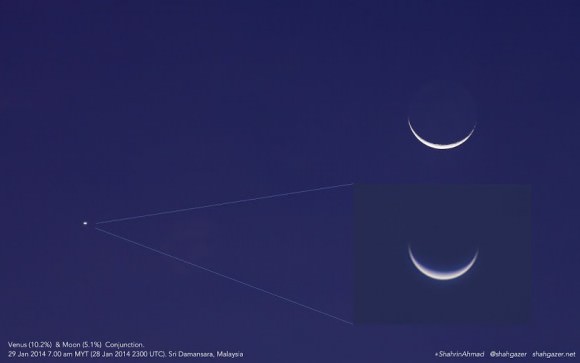
Observers worldwide, including those based in Australia, Europe and the Americas will see a near miss, but early risers will still be rewarded with a brilliant dawn pairing of the second and third brightest objects in the night sky. This will also be a fine time to attempt to spot Venus in the daytime, using the nearby crescent Moon as a guide. It’s easier than you might think! In fact, Venus is actually brighter than the Moon per apparent square arc second of surface area, owing to its higher average reflectivity (known as albedo) of 80% versus the Moon’s dusky 14%.
The International Occultation Timing Association also maintains a chart of ingress and egress times for specific locations along the track of the occultation.
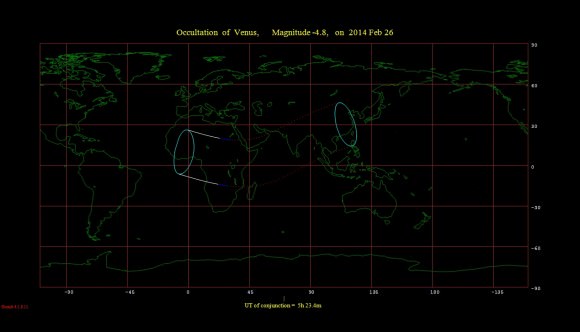
The Moon occults Venus 21 times in this decade. The last occultation of Venus by the Moon occurred on September 8th, 2013, and the next occurs October 23rd 2014 over the South Pacific in daylight skies very close to the Sun, and is unobservable.
Wednesday’s event also offers a unique opportunity to catch a crescent Venus emerging from behind the dark limb of the Moon. On Wednesday, Venus presents a 34” diameter disk that is 35% illuminated and shining at magnitude -4.3, while the Moon is a 12% illuminated crescent three days from New. Fun fact: February 2014 is missing a New Moon, meaning that both January and March will each contain two!
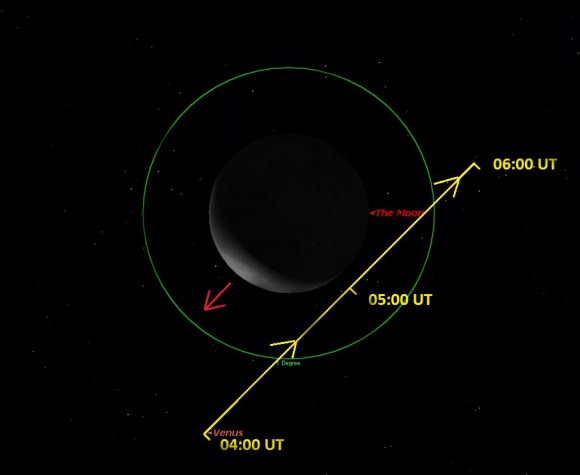
This also means that a well positioned observer in northwestern Africa would be able to see able to catch the dark limb of Venus creeping out from behind the nighttime side of the Moon against a dark sky. Such favorable occurrences only happen a handful of times per decade, and this week would be a great time to try and briefly spot – or perhaps even video or photograph – a phenomenon know as the ashen light of Venus as the dazzling crescent daytime side of the planet lay obscured by the Moon. Is this effect reported by observers over the years a fanciful illusion, or a real occurrence?
Perhaps, due to the remote location, this chance to spy and record this elusive effect will go unnoticed this time ‘round. The next chance with optimal possibilities to catch a crescent Venus occulted by the Moon against a dark sky occurs next year on October 8th, 2015, favoring the Australian outback. Anyone out there down for an observing expedition to prove or disprove the ashen light of Venus once and for all? Astronomy road trip!
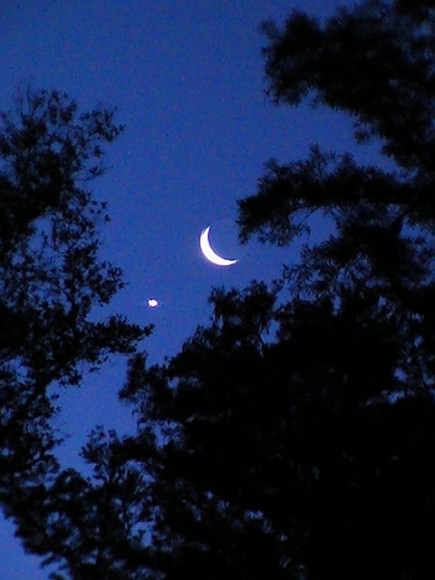
This event also provides optimal circumstances as Venus heads towards greatest elongation west of the Sun on March 22nd and the Moon-Venus pair lay 43 degrees west of the Sun during Wednesday’s event. Compare this to the impossible to observe occultation this October, when the pairing is only one degree east of the Sun! The next occultation of Venus for North America occurs next year on December 7th, 2015 and will be visible in the daytime across the extent of the track except for Alaska and Northwestern Canada.
Vexillographers may also want to take note: this week’s Venus-Moon pairing will closely emulate the familiar crescent Moon plus star pairing seen on many national flags worldwide. Did an ancient and unrecorded occultation of Venus by the Moon inspire this meme? Tradition has it that Sultan Alp Arslan settled on the star and crescent for the flag of the Turks after witnessing a close conjunction after the defeat of the Byzantine Army at the Battle of Manzikert on August 26th, 1071 A.D. This tale, however, is almost certainly apocryphal, as no occultations of planets or bright stars by the Moon occurred on or near that date, and only two occultations of Venus by the Moon occurred that year. And Venus was less than two degrees from the Sun on that date, yet another strike against it. In fact, the only occultations of Venus by the Moon in 1071 occurred on June 29th and November 27th. Perhaps Arslan just took a while to decide…
Still, this week’s event provides a great photo-op to have “Fun with Flags” and capture the pair behind your favorite astronomical conjunction-depicting banner. And be sure to send those pics into Universe Today… methinks there’s a good chance of us running a post occultation photo-essay later this week!
Watch Venus as it Wanders Through the Dawn in 2014
Are you a chronic early riser? Observational astronomy often means late nights and early mornings as daylight lengths get longer for northern hemisphere residents in February through March. But this year offers another delight for the early morning crowd, as the Venus is hanging out in the dawn skies for most of 2014.
You may have already caught sight of the brilliant world: it’s hard to miss, currently shinning at a dazzling -4.5 magnitude in the dawn. Venus is the brightest planet as seen from Earth and the third brightest natural object in the night sky after the Sun and the Moon.
Venus just passed between the Earth and the Sun last month on January 11th at inferior conjunction. Passing over five degrees north of the Sun, this was a far cry from the historic 2012 transit of the solar disk, a feat that won’t be replicated again until 2117 AD.
But February and March offer some notable events worth watching out for as Venus wanders in the dawn.
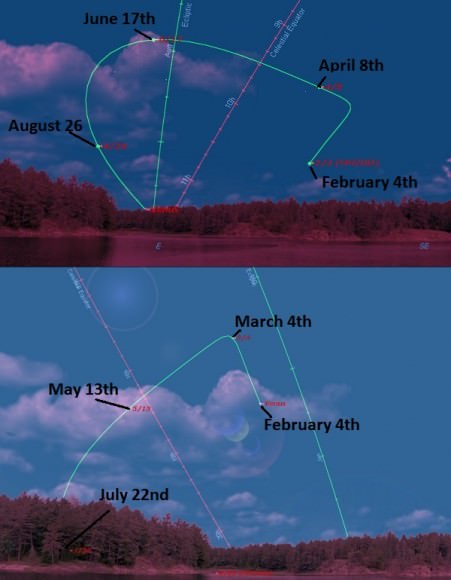
This week sees Venus thicken as a 48” 16% illuminated waxing crescent as it continues to present more of its daytime side to the Earth. We’ve always thought that it was a bit of cosmic irony that the closest planet too us presents no surface detail to observers: Venus is a cosmic tease. This assured that astronomers knew almost nothing about Venus until the dawn of the Space Age — guesses at its rotational speed and surface conditions were all widely speculative. Ideas of a vast extraterrestrial jungle or surface-spanning seas of seltzer water oceans gave way to the reality of a shrouded hellish inferno with noontime temps approaching 460 degrees Celsius. Venus is also bizarre in the fact that it rotates once every 243 Earth days, which is longer than its 224.7 day year — you could easily out walk a Venusian sunrise, that is if you could somehow survive to see it from its perpetually clouded surface!
Venus also passes 4.3 degrees from faint Pluto this week on February 5th. And while Pluto is a tough catch at over a million times fainter than Venus, it’s interesting to consider that NASA’s New Horizons and ESA’s Rosetta spacecraft are also currently off in the same general direction:
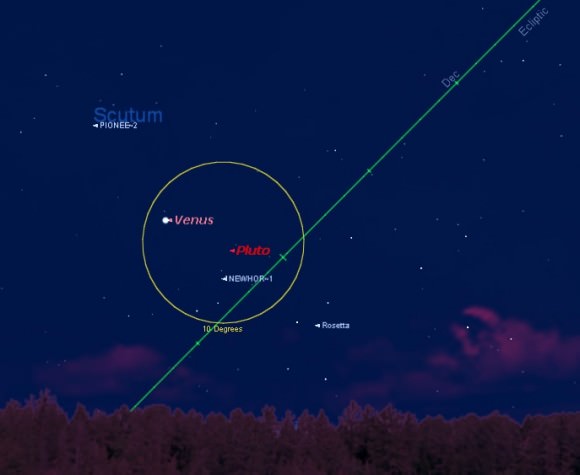
Venus also reaches greatest brilliancy at magnitude -4.6 next week on February 11th. Venus is bright enough to cast a shadow onto a high contrast background, such as freshly fallen snow. Can you see your “Venusian shadow” with the naked eye? How about photographically?
Venus then goes on to show its greatest illuminated extent to us on February 15th. This combination occurs because although the crescent of Venus is fattening, the apparent size of the disk is shrinking as the planet pulls away from us in its speedy interior orbit. Can you spy the elusive “ashen light of Venus” through a telescope? Long a controversy, this has been reported by observers as a dim “glow” on the nighttime hemisphere of Venus. Proposed explanations for the ashen light of Venus over the years have been airglow, aurorae, lightning, Venusian land clearing activity (!) or, more likely, an optical illusion.
And speaking of which, the crescent Venus gets occulted by the waning crescent Moon on February 26th. Observers in western Africa will see this occur in the predawn skies, and the rest of us will see a close pass of the pair worldwide. Can you spot Venus near the crescent Moon in the daytime sky on the 26th?
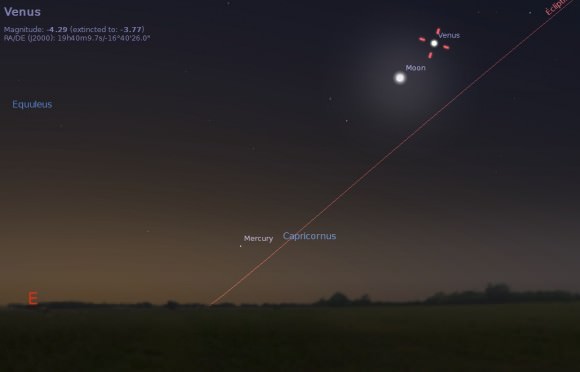
In March, Venus begins the slide southward towards the point occupied by the Sun months earlier and heads towards its greatest westward elongation for 2014 on March 22nd at 46.6 degrees west of the Sun. Interestingly, Venus is tracing out roughly the same track it took 8 years ago in 2006 and will trace again in 2022, when it will also spend a majority of the year in the dawn once again. The 8-year repeating cycle of Venus is a result of the planet completing very nearly 13 orbits of the Sun to our 8. Ancient cultures, including the Maya, Egyptians, and Babylonian astronomers all knew of this period.
Through the telescope, Venus appears at a tiny “half-moon” phase 50% illuminated at greatest elongation, a point known as dichotomy. It’s interesting to note that theoretical and observed dichotomy can actually vary by several days surrounding greatest elongation. An optical phenomenon, or a true observational occurrence? When do you judge that dichotomy occurs in 2014?
In April, one of the closest planetary conjunctions occurs of 2014 on the 12th involving Neptune and Venus at just 40’ apart, a little over the span of a Full Moon. Can you squeeze both into an eyepiece field of view? At +7.7th magnitude, Neptune shines at over 25,000 times fainter than Venus. Neith, the spurious “moon” of Venus described by 18th century astronomers lives!
But two even more dramatic conjunctions occur late in the summer, when Jupiter passes just 15’ from Venus on August 18th and Regulus stands just 42’ from Venus on September 5th. Fun fact: Venus actually occulted Regulus last century on July 7th, 1959!
From there on out, Venus heads toward superior conjunction on the far side of the Sun on October 25th, to once again emerge into the dusk sky through late 2014 and 2015.
Be sure to check out these dawn exploits of Venus through this Spring season and beyond!
Bright Venus Takes Center Stage in November
“What’s that bright object to the southwest at dusk?” We’ve already fielded more than a few such questions as Earth’s sister world shines in the dusk sky. Venus just passed its maximum elongation 47 degrees east of the Sun on November 1st, and currently shines at a brilliant magnitude -4.46. This is almost 16 times brighter than the brightest star in the sky, -1.46th magnitude Sirius.
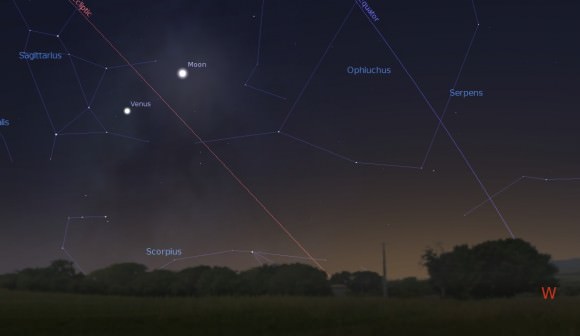
Just like the Moon, Venus goes through a full range of phases. Through the telescope, Venus currently presents a 26.7” diameter disk. That size will swell to almost 40” by month’s end, as Venus begins to approach the Earth and presents a noticeable crescent phase. We just passed dichotomy — the theoretical point where Venus presents a half-illuminated phase as seen from Earth — on October 31st, and Venus already shows a noticeable crescent:
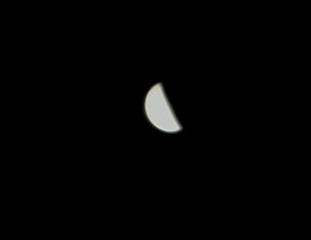
Note that we say “theoretical” because there’s typically a discrepancy of a day or two between predicted and observed dichotomy. This is also known as Schröter’s Effect. One probable cause for this is the dazzling appearance of the disk of Venus. We typically use a variable polarizing filter to cut the glare of Venus down at the eyepiece.
You might also note that Venus currently occupies the “basement” of the zodiac in the constellation Sagittarius. In fact, the planet is currently as far south as it can go, sitting at a declination of -27° 14’ on this very evening. You have to go all the way back to 1930 to find a more southerly declination of Venus, just 12’ lower!
But you won’t have to wait much longer to break that record, as the chart below shows for the most southerly declinations of Venus for the next half century:
| Year | Date | Declination |
| 2013 | November 6th | -27° 09’ |
| 2021 | “ “ | -27° 14’ |
| 2029 | “ “ | -27° 18’ |
| 2037 | “ “ | -27° 23’ |
| 2045 | “ “ | -27° 29’ |
| 2053 | “ “ | -27° 34’ |
| 2061 | “ “ | -27° 39’ |
Note that each event occurs on November 6th, and they’re spaced 8 years apart. Apparitions of Venus closely duplicate their paths in the sky over an 8 year cycle. This is because the planet nearly completes 13 orbits of the Sun for our 8. Venus “catches up” to the Earth on its interior orbit once every 584 days to reach inferior conjunction. It usually passes above or below the Sun from our vantage point, though last year it transited, a feat that won’t be witnessed again until 2117 AD.
How far south can Venus go? Well, its orbit is tilted 3.4 degrees relative to the ecliptic. It can reach a southern declination of -28 05’, though you have to go way back to 1874 for its last occurrence!
Today is also a great time to try your hand at spotting Venus in the daytime, as a 3-day old waxing crescent Moon lies about eight degrees to its upper right:
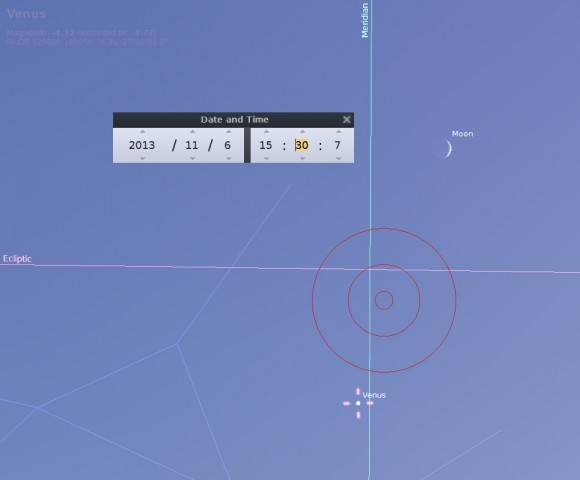
Note that seeing Venus in the daytime is surprisingly easy, once you known exactly where to look for it. Your best chances are around mid-afternoon at about 3PM local, when the daytime Moon and Venus lie highest in the southern sky. Did you know that Venus is actually intrinsically brighter per square arc second than the Moon? It’s true! The Moon actually has a very low reflective albedo of 12% — about the equivalent of fresh asphalt — while the cloud tops of Venus are more akin the fresh snow with an albedo of about 80%.
Its also worth checking out Venus and its local environs after nightfall as it passes near the Lagoon (M8) and the Trifid nebula (M8) on the night of November 6th. Continuing with its trek across the star rich plane of the heart of the Milky Way galaxy, Venus also passes near the globular cluster M22 on November 13th.
Venus also sits in the general of Pluto on November 15th, lying just 6.6 degrees south of it. Be sure to wave in the general direction of NASA’s New Horizons spacecraft bound for Pluto in July 2015 tonight as well, using the Moon and Venus for a guide:
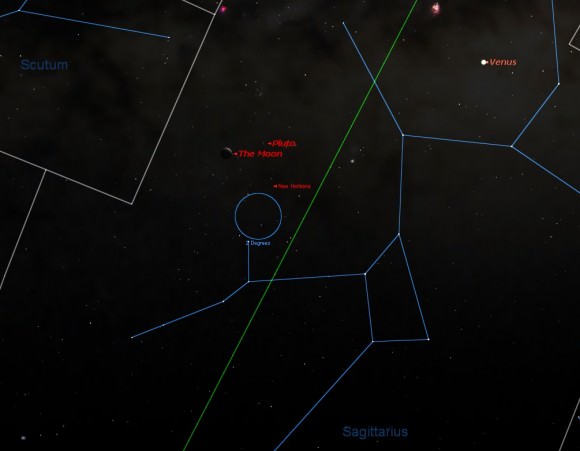
Another shot at seeing Venus paired with the Moon occurs on December 5th.
Venus also presents a maximum area of illumination on December 6th, and will shine at its brightest on December 10th at magnitude -4.7. Can you catch it casting a shadow? The best time to search for this illusive phenomenon would be just before New Moon on December 2nd. A dark sky site away from any other sources of illumination, and a snow covered ground providing high contrast also helps. Fortunately, snow isn’t in short supply in the northern hemisphere in December!
Venus is currently the only naked eye planet in the November early evening sky. We always thought that it’s a bit of a cosmic irony that the nearest planet presents a dazzling, but featureless white disk as seen from Earth. Diligent amateurs have, however, been able to tease out cloud patterns on Venus using UV filters.
Another elusive phenomenon to watch for as Venus reaches a crescent phase is ashen light. Long reported by observers, a faint glow on the night side of Venus is something that persists, but shouldn’t be. A similar effect seen on the night side of the Moon known as Earthshine is easily explained by sunlight being reflected off of the Earth… but Venus has no moon. What gives? Frequent explanations over the years have been aurorae, electrical activity, airglow, or, more frequently cited, observer bias. The brain wants to see a filled in space, and promptly inserts it betwixt the dazzling horns of the planet.
Keep an eye on Venus as it reaches maximum brilliancy and heads towards inferior conjunction on January 11th, 2014, and a rare chance to see it on said date… more to come!

